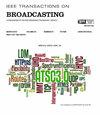Gray-Mapped NOM-Enhanced SFN: A Broadcast and Broadband Converged Transmission Solution in LTE-Based 5G Broadcast
IF 4.8
1区 计算机科学
Q2 ENGINEERING, ELECTRICAL & ELECTRONIC
引用次数: 0
Abstract
Broadcast and broadband converged transmission has emerged as a prominent research focus within broadcast technology. Abundant corresponding studies have been conducted in traditional terrestrial broadcast and 3GPP unicast systems. However, due to issues like system compatibility, traditional terrestrial broadcasts usually reveal insufficient flexibility in transmitting broadband services, and conventional unicast systems always perform inefficiently in delivering broadcast services in scenarios of converged transmission. In addition, as the current Non-Orthogonal Multiplexing (NOM) scheme employed in converged transmission usually does not comply with the Gray-mapping rule, the required codeword-level Successive Interference Cancellation (SIC) algorithm makes the Enhanced Layer (EL) data share the same processing delay as the Core Layer (CL) one, which restricts the variety of EL services. This paper focuses on the physical layer technologies of converged transmission in the 3GPP LTE-based 5G Broadcast system. Due to the inherent good compatibility with both broadcast and broadband systems, LTE-based 5G Broadcast has great potential in realizing the converged transmission of broadcast and broadband. In addition, a novel converged transmission scheme enhanced by Gray-mapped NOM is proposed in this paper, and the corresponding networking architecture, frame structure, transmitting processing, and receiving algorithms are put forward. By significantly improving the performance of the non-SIC receiving algorithm, the proposed Gray-mapped NOM-enhanced SFN (GNeSFN) scheme enables the EL customized services and the CL broadcast services to have processing delays independent from each other, bringing more flexibility to converged transmission. Link-level simulations are carried out with different system configurations and multiple channel scenarios, verifying the effectiveness and feasibility of the proposed scheme.灰度映射nomo增强SFN:基于lte的5G广播中广播与宽带融合传输的解决方案
广播与宽带融合传输已成为广播技术领域的一个重要研究热点。在传统的地面广播和3GPP单播系统中进行了大量相应的研究。然而,由于系统兼容性等问题,传统地面广播在传输宽带业务时往往灵活性不足,传统单播系统在融合传输场景下传输广播业务的效率往往不高。此外,由于当前融合传输中采用的非正交复用(NOM)方案通常不符合灰度映射规则,所需的码字级连续干扰抵消(SIC)算法使得增强层(EL)数据与核心层(CL)数据共享相同的处理延迟,限制了EL业务的多样性。本文重点研究了基于3GPP lte的5G广播系统中融合传输的物理层技术。基于lte的5G广播由于其固有的对广播和宽带系统的良好兼容性,在实现广播和宽带融合传输方面具有很大的潜力。此外,本文还提出了一种基于灰度映射NOM增强的融合传输方案,并给出了相应的网络架构、帧结构、发送处理和接收算法。本文提出的GNeSFN (grey -map nomo -enhanced SFN)方案通过显著提高非sic接收算法的性能,使EL定制业务和CL广播业务具有相互独立的处理时延,为融合传输带来更大的灵活性。在不同的系统配置和多信道场景下进行链路级仿真,验证了所提方案的有效性和可行性。
本文章由计算机程序翻译,如有差异,请以英文原文为准。
求助全文
约1分钟内获得全文
求助全文
来源期刊

IEEE Transactions on Broadcasting
工程技术-电信学
CiteScore
9.40
自引率
31.10%
发文量
79
审稿时长
6-12 weeks
期刊介绍:
The Society’s Field of Interest is “Devices, equipment, techniques and systems related to broadcast technology, including the production, distribution, transmission, and propagation aspects.” In addition to this formal FOI statement, which is used to provide guidance to the Publications Committee in the selection of content, the AdCom has further resolved that “broadcast systems includes all aspects of transmission, propagation, and reception.”
 求助内容:
求助内容: 应助结果提醒方式:
应助结果提醒方式:


